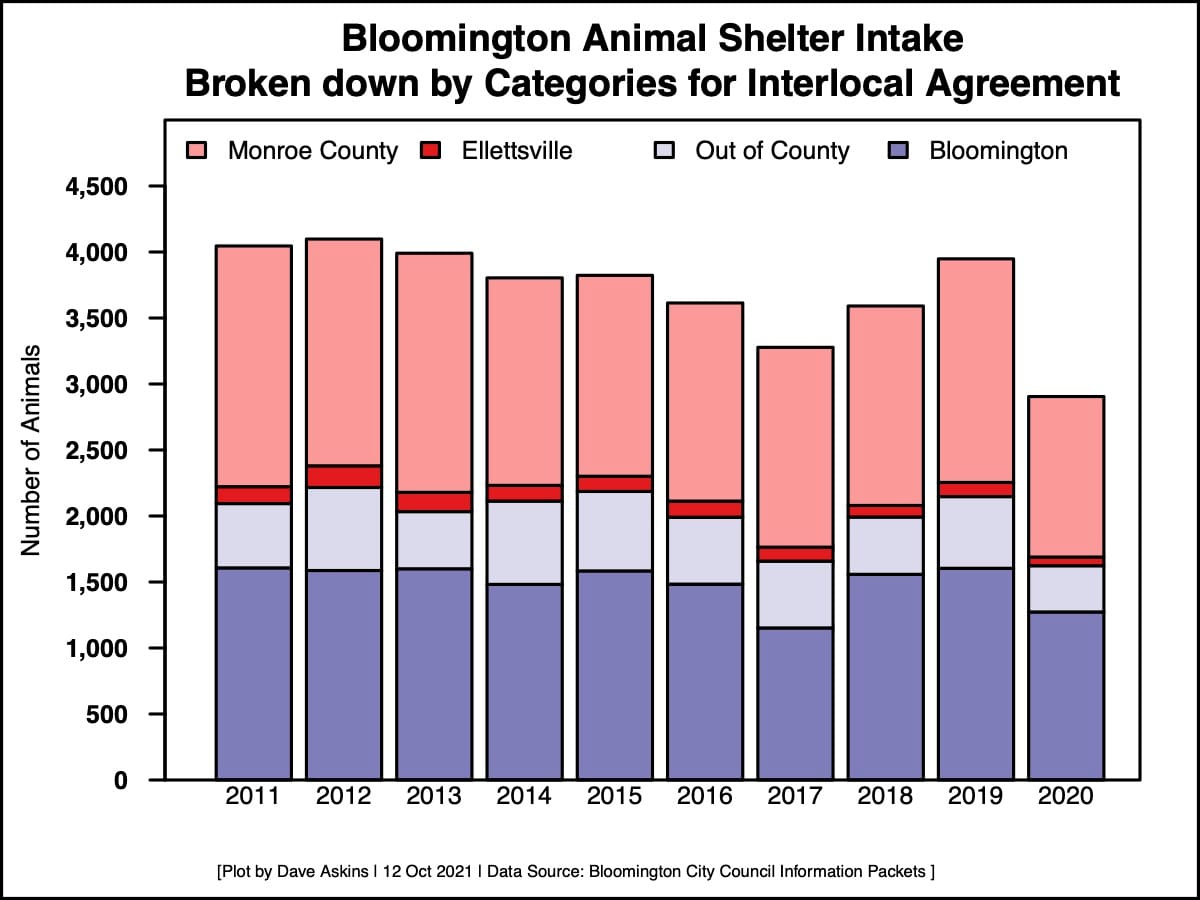Monroe County OKs animal care deal with Bloomington; shelter numbers for 2020 way down

In 2022, non-Bloomington residents will most likely be able to surrender their animals to Bloomington’s animal shelters without paying a fee, the way they have for several years.

At their regular Wednesday morning meeting, Monroe County commissioners approved their side of an interlocal agreement that the county has maintained for several years with Bloomington and Ellettsville to cover Bloomington’s cost for animals surrendered by non-city county residents and animal control officers.
On the county’s side, the interlocal agreement still needs to be approved by the county council. It will also need to be approved by the Bloomington city council.
Under the terms of this year’s agreement, the amount paid to Bloomington by Monroe County will be $342,912. Ellettsville will pay $18,612. That’s a total of $361,524.
The total is based on 1,282 animals that were surrendered to the shelter in 2020 by Monroe County or Ellettsville, at a net cost of $282 per animal.
The formula used to calculate the amounts that each government unit owes starts with the actual expenditures at the shelter. From that number, revenue from adoption fees is subtracted to get a net cost.
Under the agreement, animals that originate in the unincorporated part of the county or in the town of Ellettsville, will be housed, cared for and, if necessary, euthanized by the city of Bloomington.
On Wednesday, the item was not controversial for the three commissioners. Commissioner Lee Jones remarked on the benefit of having the arrangement with the city of Bloomington: “It used to be that you could never go down almost any road in the county without seeing a dead dog somewhere along it.”
Jones added, “And that very seldom happens now, since people no longer are just letting their animals run loose.”
President of the board of commissioners, Julie Thomas, complimented the county’s animal control officers: “I’ll give a shout out to our animal control officers that work with our sheriff’s department because they have a tough job, and they do it well.”
Monroe County and Ellettsville accounted for about 44 percent of the shelter’s 2020 total of 2,905. That’s about average for the last decade, which has been 46 percent.
The 2020 total of 2,905 is 11.4 percent lower than the previous low over the last 10 years—which was 3,278 in 2017. The high was in 2012, when 4,098 animals were taken in by the shelter.
Responding to an emailed question from The B Square, Virgil Sauder, Bloomington’s director of animal care and control wrote: “Last year was definitely an unusual year for the shelter.”
Sauder wrote that the 2020 drop was likely not due to a single factor, and there are several theories that might account for it.
Sauder wrote that the decrease from 2011 to 2017 could be partly analyzed as the impact of ongoing policy and community changes that began years ago—spay-and-neuter efforts, feral cat policies, as well as societal views of animals.
The reversal of the downward trend in 2018 came in the same year the shelter completed its renovations. “Unfortunately, as many shelters across the nation have seen, [renovations] led to increased intake for a few years,” Sauder wrote.
In the future, Sauder expects to see shelter numbers at just below 2017 levels.
As specific changes connected to 2020, Sauder pointed to home rental changes that did not occur, due to changes in hiring practices, rent assistance and other factors.
Sauder said ordinarily people who are moving, and either can’t find pet-friendly housing or do not feel it is best to take their pets to the new home, will surrender their pets to the shelter. A reduction in that kind of scenario has the potential for a big impact, because owner-surrendered pets are about half of the shelter’s normal intake.
Sauder indicated that another 2020-specific change was the launch of the shelter’s “courtesy posting” program—which allows people to use the city’s advertising platforms to find a new home for their animals, instead of depending on the shelter. The courtesy posting program has diverted a small number of animals from the shelter, Sauder wrote.
As another possible theory that might partly account for the 2020 drop, Sauder pointed to a change in human habits, connected to the pandemic. More people at home and outside allowed them to take the time to locate the home of a wayward pet without shelter intervention, Sauder wrote.




Comments ()